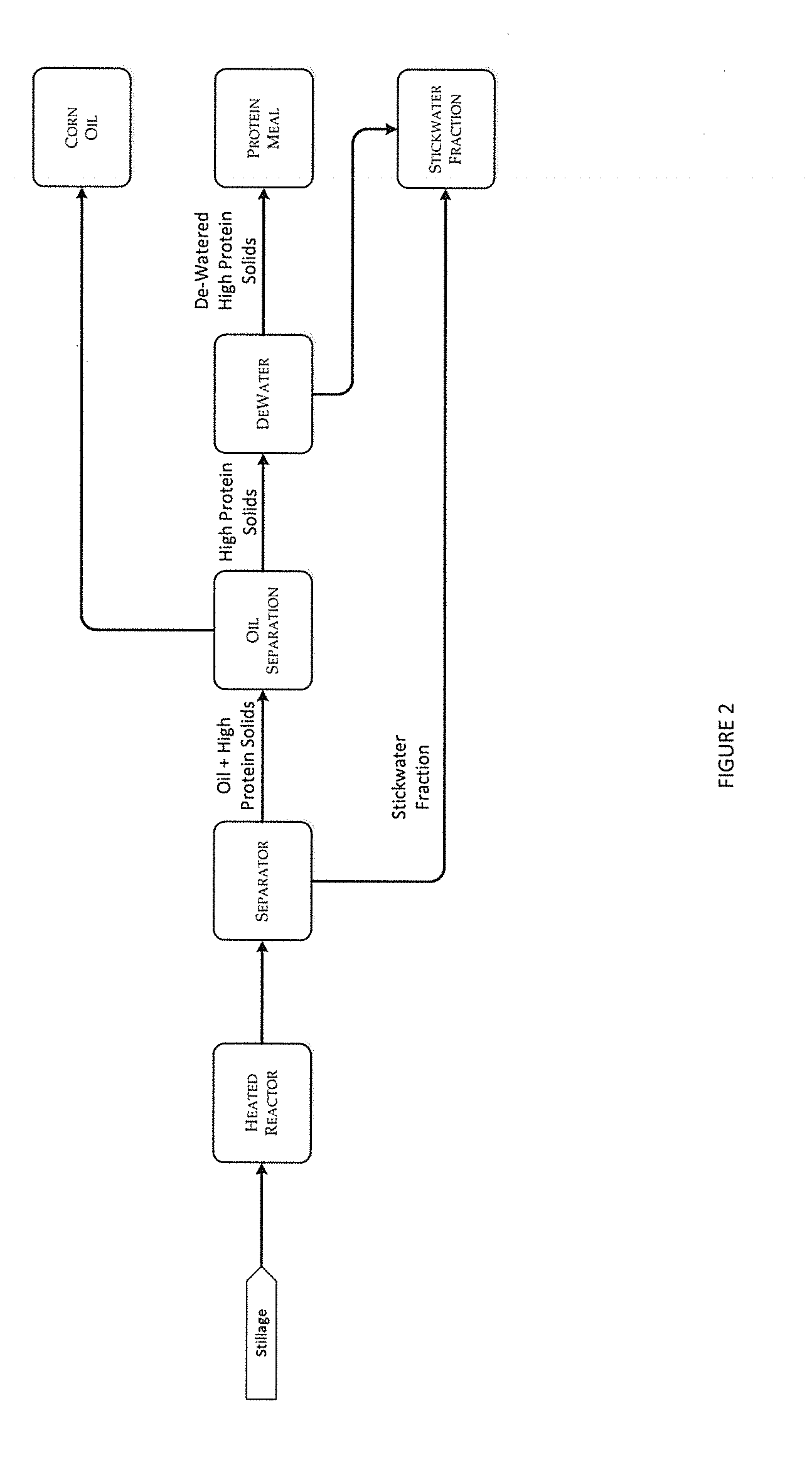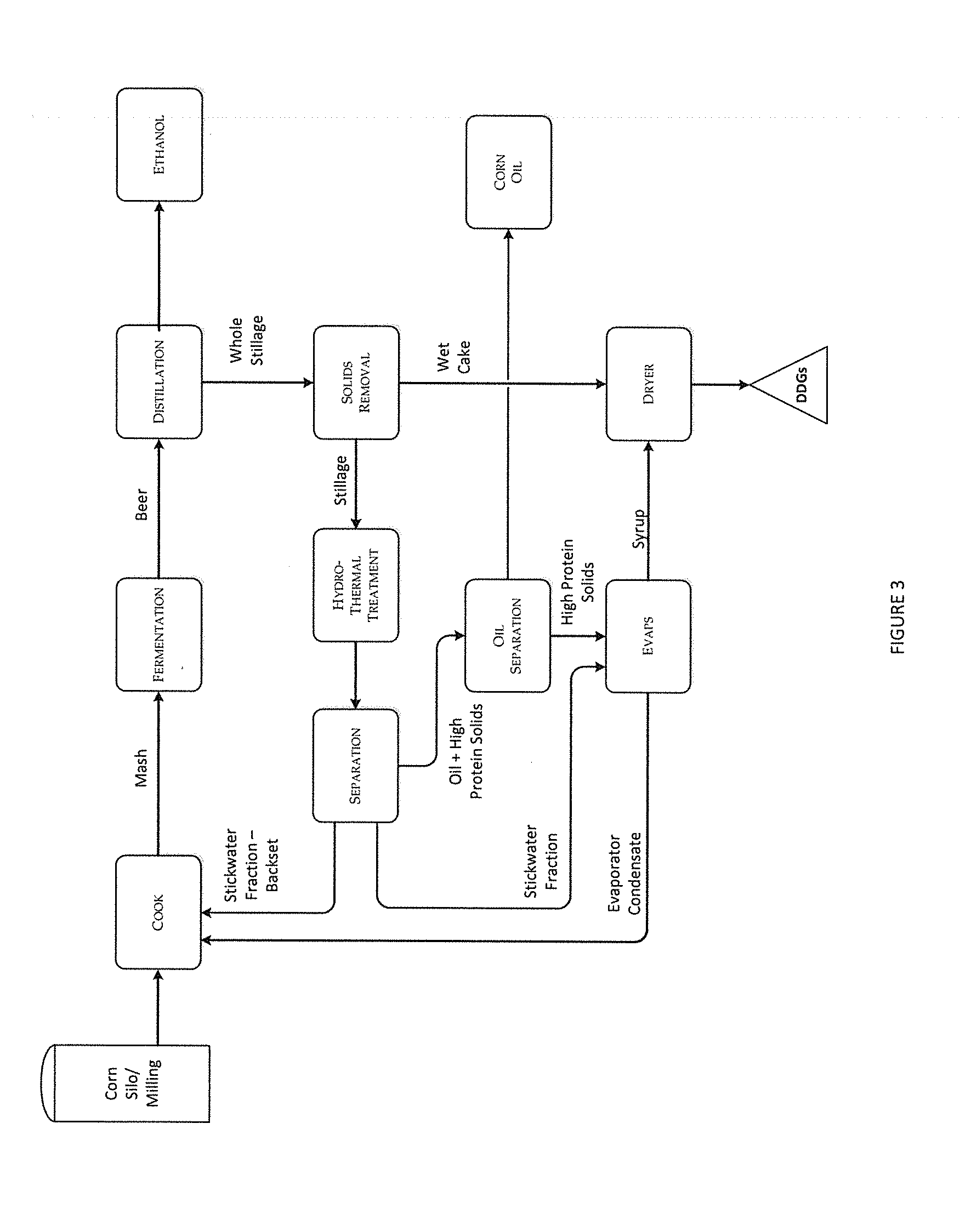Process and method for improving the water reuse, energy efficiency, fermentation and products of an ethanol fermentation plant
a technology of ethanol fermentation and process, applied in the field of stillage processing, can solve the problems of inefficiency and uneconomic recovery, increased operating costs of filtration, and products in the thin stillage that are not recovered, so as to improve biological production and recovery of valuable co-products, and improve the physicochemical properties of the stillag
- Summary
- Abstract
- Description
- Claims
- Application Information
AI Technical Summary
Benefits of technology
Problems solved by technology
Method used
Image
Examples
example 1
[0117]Analysis and Comparison of Treatment of Thin Stillage by Invention:
[0118]Procedures
[0119]For the present EXAMPLE 1, thin stillage obtained from a commercial ethanol plant was continuously pumped through a series of Plate and Frame Heat Exchangers (PHEs) into a stirred reactor. The PHEs heated the stillage to 285 degrees F. The reactor's pressure was maintained at the saturation pressure of the stillage. The reactor had a mean residence time of 40 minutes. The conditioned stillage was continuously withdrawn from the reactor and cooled to 185 degrees F., then held in a quiescent decantation tank with a mean residence time of 40 minutes. The relatively high specific gravity stickwater fraction was continuously removed from the bottom of the decantation tank while the relatively low specific gravity fraction containing fat and protein was continuously removed from the top of the decantation tank and collected. The volume ratio of stickwater fraction to fat / protein fraction was 1:1...
example 2
[0125]Analysis and Comparison of Low G Separation of Untreated Thin Stillage and Thin Stillage Treated by Invention
[0126]Procedures
[0127]For the present EXAMPLE 2, untreated thin stillage was obtained from a commercial ethanol plant. The untreated thin stillage was collected at approximately 175 degrees F. Treated stillage was prepared by heating collected thin stillage to 280 degrees F. in a stirred 1-gallon batch reactor, held for 40 minutes at temperature, and then cooled to approximately 175 degrees F. One liter containers of treated and untreated stillage at approximately 175 degrees F. were centrifuged at 400×G for 30 seconds. The samples were then divided volumetrically into a top fraction, middle fraction and bottom fraction, each representing ⅓ of the original sample volume.
[0128]Methods of Analysis
[0129]The AOAC analytical methods listed above were used in this example
[0130]Results and Discussion
[0131]FIG. 8 shows a compositional comparison of the three fractions from the ...
example 3
[0132]Fractionation of Low Specific Gravity Stream from Continuous Decantation and Comparison to Thin Stillage and DDGS
[0133]Procedures
[0134]The low specific gravity stream produced as the upper effluent of a quiescent decantation vessel by the method of EXAMPLE 1, was further fractionated by a tricanter into a second stickwater fraction, an oil fraction and a de-watered de-oiled protein fraction. This final protein fraction was analyzed for dry weight total solids, protein, and oil.
[0135]The low specific gravity stream produced by the method of EXAMPLE 1 was pumped at a rate of 3 gpm through an Andritz Decanter Model D3L operating at 3000×G. Oil was collected from the skimmer, the second stickwater fraction was collected as the centrate and the de-oiled de-watered protein fraction was collected as the wet cake.
[0136]Untreated thin stillage was also collected and pumped at the same rate through the same decanter at the same settings.
[0137]The wet material was then dried in a 105 deg...
PUM
| Property | Measurement | Unit |
|---|---|---|
| temperatures | aaaaa | aaaaa |
| specific gravity | aaaaa | aaaaa |
| diameter | aaaaa | aaaaa |
Abstract
Description
Claims
Application Information
 Login to View More
Login to View More - Generate Ideas
- Intellectual Property
- Life Sciences
- Materials
- Tech Scout
- Unparalleled Data Quality
- Higher Quality Content
- 60% Fewer Hallucinations
Browse by: Latest US Patents, China's latest patents, Technical Efficacy Thesaurus, Application Domain, Technology Topic, Popular Technical Reports.
© 2025 PatSnap. All rights reserved.Legal|Privacy policy|Modern Slavery Act Transparency Statement|Sitemap|About US| Contact US: help@patsnap.com



